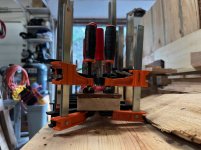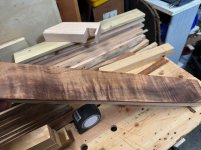onocoffee
Member
I've been thinking about putting together an 18" (or so) round side table made mostly of hard maple. What I would like to do is inlay/laminate a strip of Hawaiian koa in the center. The top will need to be assembled from 6" 3/4 hard maple boards.
However, the strip of koa that I have is currently 10mm thick and needs to be planed just a little. I'm guessing it will be 8mm when ready. I've been thinking that I will take a matching width board of hard maple, glue the two boards together and then cut them to be the same width and then plane down to a thickness that matches the rest of the top and glue it all together.
Yesterday, this video came across my feed and he's talking about using Gorilla glue for reasons and that laminating only one side of a board can give you problems.
I don't know how much I can rely upon his word, so I'm asking you. What kind of issues can laminating these two boards together pose over the long term? Should I be using a different glue than Titebond II? And are there any other considerations I should be considering?
Thanks!
This is the video:
However, the strip of koa that I have is currently 10mm thick and needs to be planed just a little. I'm guessing it will be 8mm when ready. I've been thinking that I will take a matching width board of hard maple, glue the two boards together and then cut them to be the same width and then plane down to a thickness that matches the rest of the top and glue it all together.
Yesterday, this video came across my feed and he's talking about using Gorilla glue for reasons and that laminating only one side of a board can give you problems.
I don't know how much I can rely upon his word, so I'm asking you. What kind of issues can laminating these two boards together pose over the long term? Should I be using a different glue than Titebond II? And are there any other considerations I should be considering?
Thanks!
This is the video:



